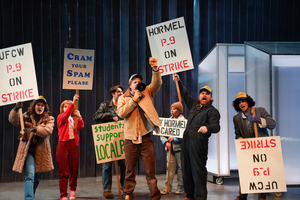Review: SPAMTOWN, USA explores Minnesota history at Children's Theatre Company

Part of being a parent is shielding your children from the harsh realities of life, whether that be arguments over money, family disagreements or work issues. But what happens when everywhere you turn, reality is staring you in the face? In Spamtown USA, playing at The Children's Theatre through April 5th, both children and adults have to deal with the ramifications of how a strike at the local meat packing plant will affect everyone in town.
Based on true events, the play written by Philip Dawkins and directed by Will Davis tells the story of the 1985 P-9 Hormel Strike in Austin, Minnesota. This world premiere production was crafted from interviews with 30 people who lived through the strike, including 25 children. The strike is seen through the eyes of five children and their parents, a composite of characters and stories gleaned through the interview process. The strike divided the town of Austin into executives and laborers, and over the course of a year (making this the longest strike in Minnesota history), families and friends found themselves on opposite sides of the fight.
What is most ingenious about this play is how we are told the story through a child's perspective. Children are often excluded from adult conversation, only hearing bits and pieces of what's happening. That can be extremely frustrating, and all the child actors portray this confusion and frustration very well. They want to know what's going on (well, mostly - as the children grow and mature during the course of the play, they get increasingly angry at being dismissed and ignored) and eventually are forced, through family ties, to take sides.
As this was my first time seeing a show at Children's Theatre, I was not sure what level of skill to expect from the child actors. I was very happy to find that they were all remarkable - each one extremely dedicated to bringing their characters to life. The play is very wordy and fast-paced - the amount of dialogue they needed to memorize was daunting, and they all came across as seasoned pros. Particularly impressive was Arden Michalec as Amy Bolton, the fashion-obsessed daughter of a Hormel executive. She had to carry a lot of the emotional weight of the play, and was able to bring maturity and a growing distress and tension to each scene. Zachary Sullivan as Travis Olsen, a laborer's son, gave a touching performance as a young man torn between his love for the "rich girl" and his family's demands for loyalty.
Set in the 1980's, the time period was instantly recognizable to anyone who lived through it, based on costumes alone. A child of the 80's myself, I vividly remember crimped hair, pastel shirts, acid-washed jeans, and trying desperately to look like Madonna. Costume designer Trevor Bowen did a wonderful job differentiating the working class from the upper class, and the style felt distinctly Minnesotan.
Sets and Lighting were also ingeniously used to create drama while not distracting from the story. An industrial plastic strip curtain separates the children from the strike, only allowing the audience to see the adults through backlighting, making them appear larger than life and scary in their intensity. Scenic Designer Christopher Heilman created a half-circle of military combat boots, symbolizing the National Guard troops that came to Austin to keep the peace when the strike got particularly violent. It was a potent way to help the audience visualize just how serious the strike became.
My date for the evening was my 10 year old son. I was curious to see what he would think about this play and if he would be able to follow along with the story (the play is recommended for children ages 9 and up). When the lights went up at the end of Act One, he immediately proclaimed, "I like this!" and we spent intermission discussing what a strike is and how the strike affected this small town. Our car ride home was filled with conversation about the consequences of a strike and the ramifications of a strike for the people involved. A show that stimulates the mind of a child to think more broadly about the world around him is part of the mission and vision of CTC, and is something that will bring both kids and parents alike back to the theater over and over again.
Photo Credit: Glen Stubbe Photography
Reader Reviews
Videos

